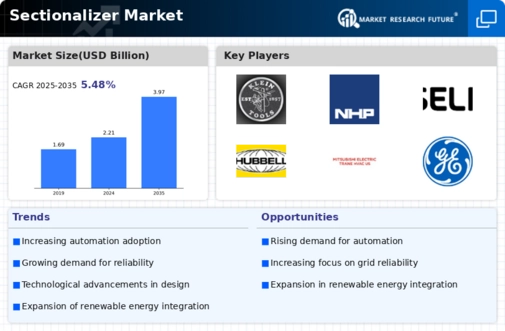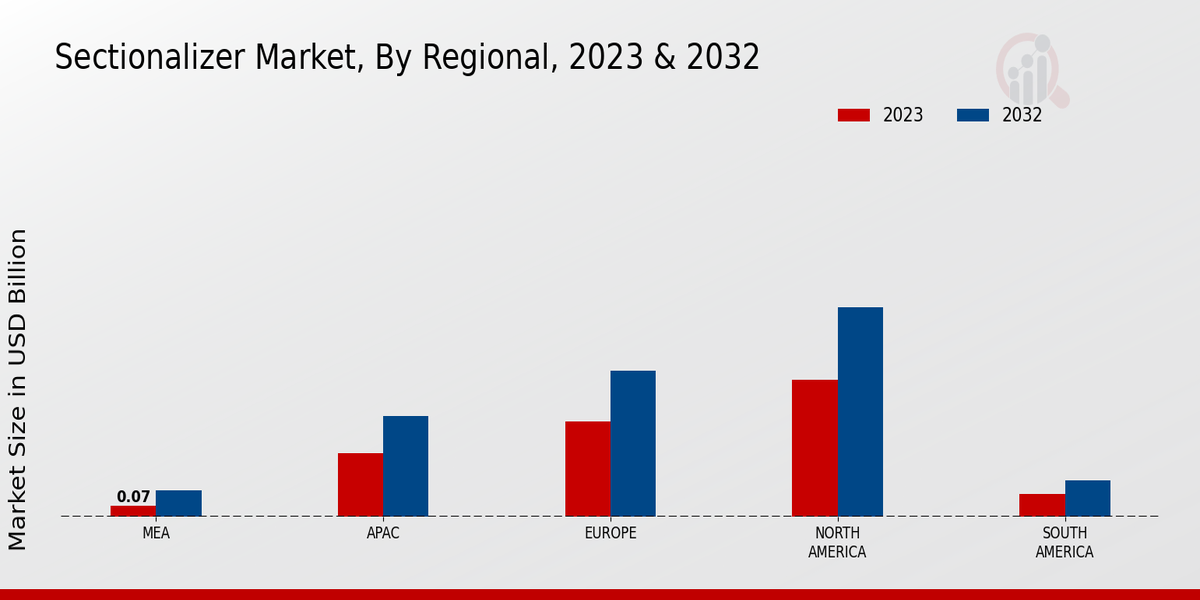Market Growth Projections
The Global Sectionalizer Market Industry is projected to experience substantial growth over the next decade. With a market value anticipated to reach 2.21 USD Billion in 2024 and further increase to 3.97 USD Billion by 2035, the industry is poised for a robust expansion. The compound annual growth rate of 5.46% from 2025 to 2035 highlights the increasing demand for sectionalizers driven by technological advancements, regulatory support, and the integration of renewable energy sources. This growth trajectory underscores the importance of sectionalizers in modern electrical distribution systems.
Rising Demand for Smart Grids
The increasing global emphasis on smart grid technologies is a pivotal driver for the Global Sectionalizer Market Industry. As utilities strive to enhance grid reliability and efficiency, sectionalizers play a crucial role in fault isolation and restoration processes. The integration of advanced monitoring and control systems within smart grids necessitates the deployment of sectionalizers, which can effectively manage electrical distribution. This trend is expected to propel the market, with projections indicating a market value of 2.21 USD Billion in 2024, reflecting the growing investment in smart infrastructure.
Regulatory Support and Incentives
Government policies and regulations aimed at enhancing grid reliability and safety are vital drivers for the Global Sectionalizer Market Industry. Many nations are implementing standards that mandate the use of sectionalizers in electrical distribution networks to minimize outages and improve service quality. These regulatory frameworks often come with incentives for utilities to upgrade their infrastructure, thereby boosting the demand for sectionalizers. As a result, the market is anticipated to grow steadily, with a compound annual growth rate of 5.46% projected from 2025 to 2035, reflecting the positive impact of regulatory support.
Focus on Renewable Energy Integration
The transition towards renewable energy sources is significantly influencing the Global Sectionalizer Market Industry. As countries worldwide commit to reducing carbon emissions, the integration of solar, wind, and other renewable sources into existing grids becomes essential. Sectionalizers facilitate this integration by ensuring that the grid remains stable and operational during fluctuations in energy supply. This trend is likely to drive market growth, as the demand for sectionalizers is expected to rise in tandem with the increasing share of renewables in the energy mix, contributing to a projected market size of 3.97 USD Billion by 2035.
Urbanization and Infrastructure Development
The ongoing urbanization and infrastructure development across the globe are significant contributors to the Global Sectionalizer Market Industry. As cities expand and new residential and commercial areas are developed, the demand for reliable electrical distribution systems increases. Sectionalizers are essential for managing the complexities of urban electrical networks, ensuring that power is distributed efficiently and outages are minimized. This trend is expected to sustain market growth, as urban areas continue to evolve and require upgraded electrical infrastructure to support their growing populations.
Technological Advancements in Sectionalizers
Innovations in sectionalizer technology are reshaping the Global Sectionalizer Market Industry. The development of digital sectionalizers equipped with advanced communication capabilities allows for real-time monitoring and data analysis, enhancing operational efficiency. These technological advancements enable utilities to respond swiftly to faults and optimize maintenance schedules, thereby reducing downtime and operational costs. As utilities increasingly adopt these advanced solutions, the market is poised for growth, driven by the need for more efficient and reliable electrical distribution systems.














